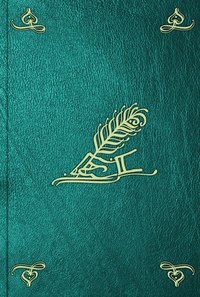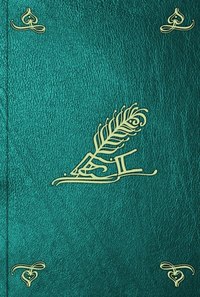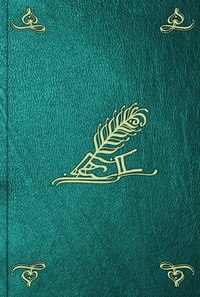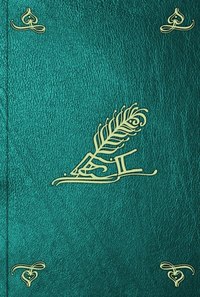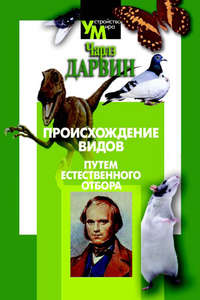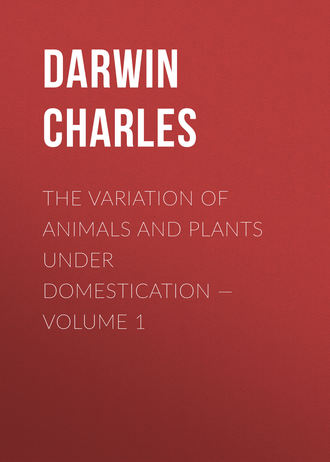 полная версия
полная версияThe Variation of Animals and Plants under Domestication — Volume 1
Herr Magnus asserts with much truth that graft-hybrids resemble in all respects seminal hybrids, including their great diversity of character. There is, however, a partial exception, inasmuch as the characters of the two parent forms are not often homogeneously blended together in graft- hybrids. They much more commonly appear in a segregated condition, — that is, in segments either at first, or subsequently through reversion. It would seem that the reproductive elements are not so completely blended by grafting as by sexual generation. But segregation of this kind occurs by no means rarely, as will be immediately shown, in seminal hybrids. Finally it must, I think, be admitted that we learn from the foregoing cases a highly important physiological fact, namely, that the elements that go to the production of a new being, are not necessarily formed by the male and female organs. They are present in the cellular tissue in such a state that they can unite without the aid of the sexual organs, and thus give rise to a new bud partaking of the characters of the two parent-forms.
ON THE SEGREGATION OF THE PARENTAL CHARACTERS IN SEMINAL HYBRIDS BY BUD- VARIATION.
I will now give a sufficient number of cases to show that segregation of this kind, namely, by buds, may occur in ordinary hybrids raised from seed.
[Hybrids were raised by Gartner between Tropaeolum minus and majus (11/116. 'Bastarderzeugung' s. 549. It is, however, doubtful whether these plants should be ranked as species or varieties.) which at first produced flowers intermediate in size, colour, and structure between their two parents; but later in the season some of these plants produced flowers in all respects like those of the mother-form, mingled with flowers still retaining the usual intermediate condition. A hybrid Cereus between C. speciosissimus and phyllanthus (11/117. Gartner ibid s. 550.) plants which are widely different in appearance, produced for the first three years angular, five- sided stems, and then some flat stems like those of C. phyllanthus. Kolreuter also gives cases of hybrid Lobelias and Verbascums, which at first produced flowers of one colour, and later in the season, flowers of a different colour. (11/118. 'Journal de Physique' tome 23 1873 page 100. 'Act. Acad. St. Petersburgh' 1781 part 1 page 249.) Naudin (11/119. 'Nouvelles Archives du Museum' tome 1 page 49.) raised forty hybrids from Datura laevis fertilised by D. stramonium; and three of these hybrids produced many capsules, of which a half, or quarter, or lesser segment was smooth and of small size, like the capsule of the pure D. laevis, the remaining part being spinose and of larger size, like the capsule of the pure D. stramonium: from one of these composite capsules, plants perfectly resembling both parent-forms were raised.
Turning now to varieties. A SEEDLING apple, conjectured to be of crossed parentage, has been described in France (11/120. L'Hermes January 14, 1837 quoted in Loudon's 'Gardener's Mag.' volume 13 page 230.) which bears fruit with one half larger than the other, of a red colour, acid taste, and peculiar odour; the other side being greenish-yellow and very sweet: it is said scarcely ever to include perfectly developed seed. I suppose that this is not the same tree as that which Gaudichaud (11/121. 'Comptes Rendus' tome 34 1852 page 746.) exhibited before the French institute, bearing on the same branch two distinct kinds of apples, one a reinette rouge, and the other like a reinette canada jaunatre: this double-bearing variety can be propagated by grafts, and continues to produce both kinds; its origin is unknown. The Rev. J.D. La Touche sent me a coloured drawing of an apple which he brought from Canada, of which half, surrounding and including the whole of the calyx and the insertion of the foot-stalk, is green, the other half being brown and of the nature of the pomme gris apple, with the line of separation between the two halves exactly defined. The tree was a grafted one, and Mr. La Touche thinks that the branches which bore this curious apple sprung from the point of junction of the graft and stock: had this fact been ascertained, the case would probably have come into the class of graft-hybrids already given. But the branch may have sprung from the stock, which no doubt was a seedling.
Prof. H. Lecoq, who has made a great number of crossings between the differently coloured varieties of Mirabilis jalapa (11/122. 'Geograph. Bot. de l'Europe' tome 3 1854 page 405; and 'De la Fecondation' 1862 page 302.) finds that in the seedlings the colours rarely combine, but form distinct stripes; or half the flower is of one colour and half of a different colour. Some varieties regularly bear flowers striped with yellow, white, and red; but plants of such varieties occasionally produce on the same root branches with uniformly coloured flowers of all three tints, and other branches with half-and-half coloured flowers, and others with marbled flowers. Gallesio (11/123. 'Traite du Citrus' 1811 page 45.) crossed reciprocally white and red carnations, and the seedlings were striped; but some of the striped plants also bore entirely white and entirely red flowers. Some of these plants produced one year red flowers alone, and in the following year striped flowers; or conversely, some plants, after having borne for two or three years striped flowers, would revert and bear exclusively red flowers. It may be worth mentioning that I fertilised the PURPLE SWEET-PEA (Lathyrus odoratus) with pollen from the light-coloured PAINTED LADY: seedlings raised from the same pod were not intermediate in character, but perfectly resembled either parent. Later in the summer, the plants which had at first borne flowers identical with those of the PAINTED LADY, produced flowers streaked and blotched with purple; showing in these darker marks a tendency to reversion to the mother-variety. Andrew Knight (11/124. 'Transact. Linn. Soc.' volume 9 page 268.) fertilised two white grapes with pollen of the Aleppo grape, which is darkly variegated both in its leaves and fruit. The result was that the young seedlings were not at first variegated, but all became variegated during the succeeding summer; besides this, many produced on the same plant bunches of grapes which were all black, or all white, or lead-coloured striped with white, or white dotted with minute black stripes; and grapes of all these shades could frequently be found on the same foot-stalk.
I will append a very curious case, not of bud-variation, but of two cohering embryos, different in character and contained within the same seed. A distinguished botanist, Mr. G.H. Thwaites (11/125. 'Annals and Mag. of Nat. Hist.' March 1848.) states that a seed from Fuchsia coccinea fertilised by F. fulgens, contained two embryos, and was "a true vegetable twin." The two plants produced from the two embryos were "extremely different in appearance and character," though both resembled other hybrids of the same parentage produced at the same time. These twin plants "were closely coherent, below the two pairs of cotyledon-leaves, into a single cylindrical stem, so that they had subsequently the appearance of being branches on one trunk." Had the two united stems grown up to their full height, instead of dying, a curiously mixed hybrid would have been produced. A mongrel melon described by Sageret (11/126. 'Pomologie Physiolog.' 1830 page 126.) may perhaps have thus originated; for the two main branches, which arose from two cotyledon-buds, produced very different fruit, — on the one branch like that of the paternal variety, and on the other branch like to a certain extent that of the maternal variety, the melon of China.]
In most of these cases of crossed varieties, and in some of the cases of crossed species, the colours proper to both parents appeared in the seedlings, as soon as they first flowered, in the form of stripes or larger segments, or as whole flowers or fruit of different kinds borne on the same plant; and in this case the appearance of the two colours cannot strictly be said to be due to reversion, but to some incapacity of fusion. When, however, the later flowers or fruit produced during the same season, or during a succeeding year or generation, become striped or half-and-half, etc., the segregation of the two colours is strictly a case of reversion by bud-variation. Whether all the many recorded cases of striped flowers and fruit are due to previous hybridisation and reversion is by no means clear, for instance with peaches and nectarines, moss-roses, etc. In a future chapter I shall show that, with animals of crossed parentage, the same individual has been known to change its character during growth, and to revert to one of its parents which it did not at first resemble. Finally, from the various facts now given, there can be no doubt that the same individual plant, whether a hybrid or a mongrel, sometimes returns in its leaves, flowers, and fruit, either wholly or by segments, to both parent- forms.
ON THE DIRECT OR IMMEDIATE ACTION OF THE MALE ELEMENT ON THE MOTHER FORM.
Another remarkable class of facts must be here considered, firstly, because they have a high physiological importance, and secondly, because they have been supposed to account for some cases of bud-variation. I refer to the direct action of the male element, not in the ordinary way on the ovules, but on certain parts of the female plant, or in case of animals on the subsequent progeny of the female by a second male. I may premise that with plants the ovarium and the coats of the ovules are obviously parts of the female, and it could not have been anticipated that they would have been affected by the pollen of a foreign variety or species, although the development of the embryo, inside the embryonic sack, inside the ovule and ovarium, of course, depends on the male element.
[Even as long ago as 1729 it was observed (11/127. 'Philosophical Transact.' volume 43 1744-45 page 525.) that white and blue varieties of the Pea, when planted near each other, mutually crossed, no doubt through the agency of bees, and in the autumn blue and white peas were found within the same pods. Wiegmann made an exactly similar observation in the present century. The same result has followed several times when a variety with peas of one colour has been artificially crossed by a differently-coloured variety. (11/128. Mr. Goss 'Transact. Hort. Soc.' volume 5 page 234: and Gartner 'Bastarderzeugung' 1849 ss. 81 and 499.) These statements led Gartner, who was highly sceptical on the subject, carefully to try a long series of experiments: he selected the most constant varieties, and the result conclusively showed that the colour of the skin of the pea is modified when pollen of a differently coloured variety is used. This conclusion has since been confirmed by experiments made by the Rev. J.M. Berkeley. (11/129. 'Gardener's Chronicle' 1854 page 404.)
Mr. Laxton of Stamford, whilst making experiments on peas for the express purpose of ascertaining the influence of foreign pollen on the mother- plant, has recently (11/130. Ibid 1866 page 900.) observed an important additional fact. He fertilised the Tall Sugar-pea, which bears very thin green pods, becoming brownish-white when dry, with pollen of the Purple- podded pea, which, as its name expresses, has dark-purple pods with very thick skin, becoming pale reddish purple when dry. Mr. Laxton has cultivated the tall sugar-pea during twenty years, and has never seen or heard of it producing a purple pod: nevertheless, a flower fertilised by pollen from the purple-pod yielded a pod clouded with purplish-red which Mr. Laxton kindly gave to me. A space of about two inches in length towards the extremity of the pod, and a smaller space near the stalk, were thus coloured. On comparing the colour with that of the purple pod, both pods having been first dried and then soaked in water, it was found to be identically the same; and in both the colour was confined to the cells lying immediately beneath the outer skin of the pod. The valves of the crossed pod were also decidedly thicker and stronger than those of the pods of the mother-plant, but this may possibly have been an accidental circumstance, for I know not how far their thickness is a variable character in the Tall Sugar-pea.
The peas of the Tall Sugar-pea, when dry, are pale greenish-brown, thickly covered with dots of dark purple so minute as to be visible only through a lens, and Mr. Laxton has never seen or heard of this variety producing a purple pea; but in the crossed pod one of the peas was of a uniform beautiful violet-purple tint, and a second was irregularly clouded with pale purple. The colour lies in the outer of the two coats which surround the pea. As the peas of the purple-podded variety when dry are of a pale greenish-buff, it would at first appear that this remarkable change of colour in the peas in the crossed pod could not have been caused by the direct action of the pollen of the purple-pod: but when we bear in mind that this latter variety has purple flowers, purple marks on its stipules, and purple pods; and that the Tall Sugar-pea likewise has purple flowers and stipules, and microscopically minute purple dots on the peas, we can hardly doubt that the tendency to the production of purple in both parents has in combination modified the colour of the peas in the crossed pod. After having examined these specimens, I crossed the same two varieties, and the peas in one pod but not the pods themselves, were clouded and tinted with purplish-red in a much more conspicuous manner than the peas in the uncrossed pods produced at the same time by the same plants. I may notice as a caution that Mr. Laxton sent me various other crossed peas slightly, or even greatly, modified in colour; but the change in these cases was due, as had been suspected by Mr. Laxton, to the altered colour of the cotyledons, seen through the transparent coats of the peas; and as the cotyledons are parts of the embryo, these cases are not in any way remarkable.
Turning now to the genus Matthiola. The pollen of one kind of stock sometimes affects the colour of the seeds of another kind, used as the mother-plant. I give the following case the more readily, as Gartner doubted similar statements previously made with respect to the stock by other observers. A well-known horticulturist, Major Trevor Clarke, informs me (11/131. See also a paper by this observer read before the International Hort. and Bot. Congress of London 1866.) that the seeds of the large red- flowered BIENNIAL stock, Matthiola annua (Cocardeau of the French), are light brown, and those of the purple branching Queen stock (M. incana) are violet-black; and he found that, when flowers of the red stock were fertilised by pollen from the purple stock, they yielded about fifty per cent of BLACK seeds. He sent me four pods from a red flowered plant, two of which had been fertilised by their own pollen, and they included pale brown seed; and two which had been crossed by pollen from the purple kind, and they included seeds all deeply tinged with black. These latter seeds yielded purple-flowered plants like their father; whilst the pale brown seeds yielded normal red-flowered plants; and Major Clarke, by sowing similar seeds, has observed on a greater scale the same result. The evidence in this case of the direct action of the pollen of one species on the colour of the seeds of another species appears to me conclusive.
Gallesio (11/132. 'Traite du Citrus' page 40.) fertilised the flowers of an orange with pollen from the lemon; and one fruit thus produced bore a longitudinal stripe of peel having the colour, flavour, and other characters of the lemon. Mr. Anderson (11/133. 'Transact. Hort. Soc.' volume 3 page 318. See also volume 5 page 65.) fertilised a green-fleshed melon with pollen from a scarlet-fleshed kind; in two of the fruits "a sensible change was perceptible: and four other fruits were somewhat altered both internally and externally." The seeds of the two first- mentioned fruits produced plants partaking of the good properties of both parents. In the United States, where Cucurbitaceae are largely cultivated, it is the popular belief (11/134. Prof. Asa Gray 'Proc. Acad. Sc.' Boston volume 4 1860 page 21. I have received statements to the same effect from other persons in the United States.) that the fruit is thus directly affected hy foreign pollen; and I have received a similar statement with respect to the cucumber in England. It is believed that grapes have been thus affected in colour, size, and shape: in France a pale-coloured grape had its juice tinted by the pollen of the dark-coloured Teinturier; in Germany a variety bore berries which were affected by the pollen of two adjoining kinds; some of the berries being only partially affected or mottled. (11/135. For the French case see 'Journ. Hort. Soc.' volume 1 new series 1866 page 50. For Germany see M. Jack quoted in Henfrey's 'Botanical Gazette' volume 1 page 277. A case in England has recently been alluded to by the Rev. J.M. Berkeley before the Hort. Soc. of London.)
As long ago as 1751 (11/136. 'Philosophical Transactions' volume 47 1751-52 page 206.) it was observed that, when differently-coloured varieties of maize grew near each other, they mutually affected each other's seeds, and this is now a popular belief in the United States. Dr. Savi (11/137. Gallesio 'Teoria della Riproduzione' 1816 page 95.) tried the experiment with care: he sowed yellow and black-seeded maize together, and on the same ear some of the seeds were yellow, some black, and some mottled, the differently coloured seeds being arranged irregularly or in rows. Prof. Hildebrand has repeated the experiment (11/138. 'Bot. Zeitung' May 1868 page 326.) with the precaution of ascertaining that the mother-plant was true. A kind bearing yellow grains was fertilised with pollen of a kind having brown grains, and two ears produced yellow grains mingled with others of a dirty violet tint. A third ear had only yellow grains, but one side of the spindle was tinted of a reddish-brown; so that here we have the important fact of the influence of the foreign pollen extending to the axis. Mr. Arnold, in Canada, varied the experiment in an interesting manner: "a female flower was subjected first to the action of pollen from a yellow variety, and then to that from a white variety; the result was an ear, each grain of which was yellow below and white above." (11/139. See Dr. J. Stockton-Hough 'American Naturalist' January 1874 page 29.) With other plants it has occasionally been observed that the crossed offspring showed the influence of two kinds of pollen, but in this case the two kinds affected the mother-plant.
Mr. Sabine states (11/140. 'Transact. Hort. Soc.' volume 5 page 69.) that he has seen the form of the nearly globular seed-capsule of Amaryllis vittata altered by the application of the pollen of another species, of which the capsule has gibbous angles. With an allied genus, a well-known botanist, Maximowicz, has described in detail the striking results of reciprocally fertilising Lilium bulbiferum and davuricum with each other's pollen. Each species produced fruit not like its own, but almost identical with that of the pollen-bearing species; but from an accident only the fruit of the latter species was carefully examined; the seeds were intermediate in the development of their wings. (11/141. 'Bull. de l'Acad. Imp. de St. Petersburg' tome 17 page 275, 1872. The author gives references to those cases in the So1anaceae of fruit affected by foreign pollen, but as it does not appear that the mother-plant was artificially fertilised, I have not entered into details.)
Fritz Muller fertilised Cattleya leopoldi with pollen of Epidendron cinnabarinum; and the capsules contained very few seeds; but these presented a most wonderful appearance, which, from the description given, two botanists, Hildebrand and Maximowicz, attribute to the direct action of the pollen of the Epidendron. (11/142. 'Bot. Zeitung' September 1868 page 631. For Maximowicz's judgment see the paper last referred to.)
Mr. J. Anderson Henry (11/143. 'Journal of Horticulture' January 20, 1863 page 46.) crossed Rhododendron dalhousiae with the pollen of R. nuttallii, which is one of the largest-flowered and noblest species of the genus. The largest pod produced by the former species, when fertilised with its own pollen, measured 1 2/8 inch in length and 1 1/2 in girth; whilst three of the pods which had been fertilised by pollen of R. nuttallii measured 1 5/8 inch in length and no less than 2 inches in girth. Here the effect of the foreign pollen was apparently confined to increasing the size of the ovarium; but we must be cautious in assuming, as the following case shows, that size had been transferred from the male parent to the capsule of the female plant. Mr. Henry fertilised Arabis blepharophylla with pollen of A. soyeri, and the pods thus produced, of which he was so kind as to send me detailed measurements and sketches, were much larger in all their dimensions than those naturally produced by either the male or female parent-species. In a future chapter we shall see that the organs of vegetation in hybrid plants, independently of the character of either parent, are sometimes developed to a monstrous size; and the increased size of the pods in the foregoing cases may be an analogous fact. On the other hand, M. de Saporta informs me that an isolated female plant of Pistacia vera is very apt to be fertilised by the pollen of neighbouring plants of P. terebinthus, and in this case the fruits are only half their proper size, which he attributes to the influence of the pollen of P. terebinthus.
No case of the direct action of the pollen of one variety on another is better authenticated or more remarkable than that of the common apple. The fruit here consists of the lower part of the calyx and of the upper part of the flower-peduncle (11/144. See on this head the high authority of Prof. Decaisne in a paper translated in 'Journ. Hort. Soc.' volume 1 new series 1866 page 48.) in a metamorphosed condition, so that the effect of the foreign pollen has extended even beyond the limits of the ovarium. Cases of apples thus affected were recorded by Bradley in the early part of the last century; and other cases are given in old volumes of the 'Philosophical Transactions' (11/145. Volume 43 1744-45 page 525 volume 45 1747-48 page 602.); in one of these a Russeting apple and an adjoining kind mutually affected each other's fruit; and in another case a smooth apple affected a rough-coated kind. Another instance has been given (11/146. 'Transact. Hort. Soc.' volume 5 pages 65 and 68. See also Prof. Hildebrand with a coloured figure in 'Bot. Zeitung' May 15, 1868 page 327. Puvis also has collected 'De La Degeneration' 1837 page 36) several other instances; but it is not in all cases possible to distinguish between the direct action of foreign pollen and bud-variations.) of two very different apple-trees growing close to each other, which bore fruit resembling each other, but only on the adjoining branches. It is, however, almost superfluous to adduce these or other cases, after that of the St. Valery apple, the flowers which, from the abortion of the stamens, do not produce pollen, but are fertilised by the girls of the neighbourhood with pollen of many kinds; and they bear fruit, "differing from one another in size, flavour, and colour, but resembling in character the hermaphrodite kinds by which they have been fertilised." (11/147. T. de Clermont-Tonnerre in 'Mem. de la Soc. Linn. de Paris' tome 3 1825 page 164.)]
I have now shown, on the authority of several excellent observers, in the case of plants belonging to widely different orders, that the pollen of one species or variety, when applied to the female of a distinct form, occasionally causes the coats of the seeds, the ovarium or fruit, including even the calyx and upper part of the peduncle of the apple, and the axis of the ear in maize, to be modified. Sometimes the whole ovarium or all the seeds are thus affected; sometimes only a certain number of the seeds, as in the case of the pea, or only a part of the ovarium, as with the striped orange, mottled grapes, and maize, is thus affected. It must not be supposed that any direct or immediate effect invariably follows the use of foreign pollen: this is far from being the case; nor is it known on what conditions the result depends. Mr. Knight (11/148. 'Transact. of Hort. Soc.' volume 5 page 68.) expressly states that he has never seen the fruit thus affected, though he crossed thousands of apple and other fruit-trees.




